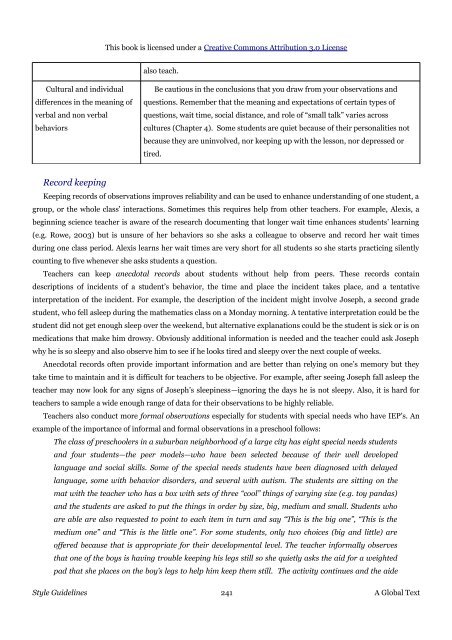Educational Psychology Third Edition Kelvin Seifert and Rosemary ...
Educational Psychology Third Edition Kelvin Seifert and Rosemary ...
Educational Psychology Third Edition Kelvin Seifert and Rosemary ...
You also want an ePaper? Increase the reach of your titles
YUMPU automatically turns print PDFs into web optimized ePapers that Google loves.
Cultural <strong>and</strong> individual<br />
differences in the meaning of<br />
verbal <strong>and</strong> non verbal<br />
behaviors<br />
Record keeping<br />
This book is licensed under a Creative Commons Attribution 3.0 License<br />
also teach.<br />
Be cautious in the conclusions that you draw from your observations <strong>and</strong><br />
questions. Remember that the meaning <strong>and</strong> expectations of certain types of<br />
questions, wait time, social distance, <strong>and</strong> role of “small talk” varies across<br />
cultures (Chapter 4). Some students are quiet because of their personalities not<br />
because they are uninvolved, nor keeping up with the lesson, nor depressed or<br />
tired.<br />
Keeping records of observations improves reliability <strong>and</strong> can be used to enhance underst<strong>and</strong>ing of one student, a<br />
group, or the whole class' interactions. Sometimes this requires help from other teachers. For example, Alexis, a<br />
beginning science teacher is aware of the research documenting that longer wait time enhances students’ learning<br />
(e.g. Rowe, 2003) but is unsure of her behaviors so she asks a colleague to observe <strong>and</strong> record her wait times<br />
during one class period. Alexis learns her wait times are very short for all students so she starts practicing silently<br />
counting to five whenever she asks students a question.<br />
Teachers can keep anecdotal records about students without help from peers. These records contain<br />
descriptions of incidents of a student’s behavior, the time <strong>and</strong> place the incident takes place, <strong>and</strong> a tentative<br />
interpretation of the incident. For example, the description of the incident might involve Joseph, a second grade<br />
student, who fell asleep during the mathematics class on a Monday morning. A tentative interpretation could be the<br />
student did not get enough sleep over the weekend, but alternative explanations could be the student is sick or is on<br />
medications that make him drowsy. Obviously additional information is needed <strong>and</strong> the teacher could ask Joseph<br />
why he is so sleepy <strong>and</strong> also observe him to see if he looks tired <strong>and</strong> sleepy over the next couple of weeks.<br />
Anecdotal records often provide important information <strong>and</strong> are better than relying on one’s memory but they<br />
take time to maintain <strong>and</strong> it is difficult for teachers to be objective. For example, after seeing Joseph fall asleep the<br />
teacher may now look for any signs of Joseph’s sleepiness—ignoring the days he is not sleepy. Also, it is hard for<br />
teachers to sample a wide enough range of data for their observations to be highly reliable.<br />
Teachers also conduct more formal observations especially for students with special needs who have IEP’s. An<br />
example of the importance of informal <strong>and</strong> formal observations in a preschool follows:<br />
The class of preschoolers in a suburban neighborhood of a large city has eight special needs students<br />
<strong>and</strong> four students—the peer models—who have been selected because of their well developed<br />
language <strong>and</strong> social skills. Some of the special needs students have been diagnosed with delayed<br />
language, some with behavior disorders, <strong>and</strong> several with autism. The students are sitting on the<br />
mat with the teacher who has a box with sets of three “cool” things of varying size (e.g. toy p<strong>and</strong>as)<br />
<strong>and</strong> the students are asked to put the things in order by size, big, medium <strong>and</strong> small. Students who<br />
are able are also requested to point to each item in turn <strong>and</strong> say “This is the big one”, “This is the<br />
medium one” <strong>and</strong> “This is the little one”. For some students, only two choices (big <strong>and</strong> little) are<br />
offered because that is appropriate for their developmental level. The teacher informally observes<br />
that one of the boys is having trouble keeping his legs still so she quietly asks the aid for a weighted<br />
pad that she places on the boy’s legs to help him keep them still. The activity continues <strong>and</strong> the aide<br />
Style Guidelines 241 A Global Text


